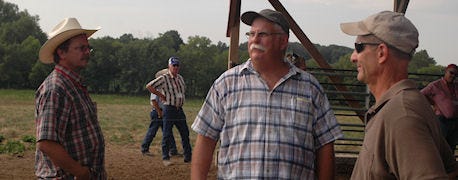
When driving down Iowa roads and highways, most farmers look at the purple flowered plant known as chicory along the roadside as a weed. However, on places like Ted Krauskopf's farm near Highland, Ill., a variation of the plant is used as forage. Cliff Schuette of Pennington Seed, Krauskopf's seed dealer, says this has paid off. "I guarantee cattle will clean that chicory down," he says. "You see Ted's cows? They're some of the fattest cows around."

Rotational grazing allows you to store some of the paddocks for certain times of the year. But with this summer's drought, regrowth is limited, says Ted Krauskopf.
Krauskopf has used rotational grazing methods for his red Angus herd since 2007 on 80 acres of pasture. With his current 35 head of cattle, he uses a Pennington Seed combination of Max-Q fescue, red and white clovers, and a variation of chicory that has more leaves. "I saw how efficient it was, and I just kept doing it," he says of his first experience. "The cows look good."
Electric fence is moved to prevent cows from overgrazing in the same area
He normally moves cows once a day, and also uses strip grazing, which gives his cattle about half an acre of fresh pasture per day. It also involves moving the back fence closer once a week to prevent cows from overgrazing in the same area. For the most part, the transition is fairly easy. "It doesn't take very long to move fences," Krauskopf notes. Taking about 20 to 30 minutes, this is possible by using "step in" posts and a geared reel for wire, almost always from the back of an ATV. "I need to be out there looking at the cows everyday anyway," he adds.
He can store specific paddocks for certain times of year. However, due to this summer's extremely dry weather, regrowth has been limited, same as many other farms. "I feel like I'm using up what I've got and I don't have much coming," he says.
Other challenges can arise as well. With a mixture of fescue, clover and chicory, Schuette notes clover can overwhelm the fescue Krauskopf relies on. Also, being located in an area with timber, he has to clip certain pastures once a year to prevent woody species from invading.
Need good watering system for cattle to counter heat and dry weather
One of the ways Krauskopf counters heat and dry weather is by supplying his cattle with rural water, rather than well water or pond water, using 6,000 feet of trenched permanent line and costing about $80 a month. "It's a good feeling to have cattle drink clean water," he says, noting this is a huge improvement in herd health compared to using pond water. "I was used to the water getting rather dirty, and the trough having to be cleaned."
Krauskopf provides his cows protection from flies by putting fly tags on the mineral feeder. "It works well," he says. Some of his fencing is also unique. It's a composite material with wood, making it flexible enough to withstand deer running over it.
The most notable facility on Krauskopf's place is his feeder building. He usually uses it during winter, when grazing land is sparse, but it also serves as a shelter from summer heat. It's nice and cool in there compared to outside. The facility is mostly designed as a form of manure management, and NRCS conservationist Dan Steinmann says with the concrete floor, this is particularly effective. "It's easy to scrape manure to the back of the building," he adds.
Advantage of feeder building
The shelter cost about $50,000 total; NRCS provided $33,000 in cost share. The cost share requires certain terms of use with the facility. "It has to be available for cattle to use at all times," Krauskopf says. Advantages include the wind block and the ventilation system. It has good ventilation. But this isn't all that's involved. "A lot of our cost share funding is based on resource concerns such as manure management and water quality," says Steinmann. "It cannot get into the creek or the pond."
Krauskopf says the facility has helped his operation, and since he made the switch to rotational grazing in 2007, he's noticed an economic benefit, partially due to equipment savings. "The rotational grazing system has raised profits," he notes. He's seen a net return of $237 per acre, as well as a premium for using this method. "I'm happy with it."
Anyone interested in learning more about rotational and strip grazing can contact Krauskopf at [email protected].
Editor's Note: Harris, a Wallaces Farmer intern, this summer accompanied 30 Iowa producers on a three-day summer beef cattle tour of farms in Iowa, Missouri and southern Illinois.
About the Author(s)
You May Also Like






